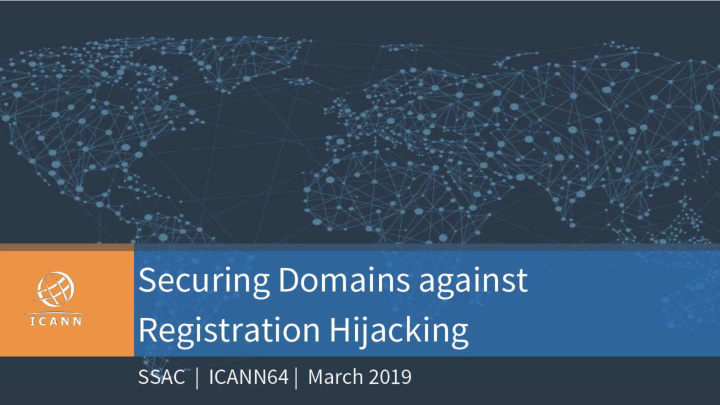



Presenters ◉ Tim April ◉ Rod Rasmussen ◉ Jay Daley | 5
Recent Domain Registration Hijacking 1. Attackers had the ability to modify registration records at the registry, typically by compromising login credentials 2. Attackers changed DNS delegations (NS) pointing the zones to the attackers' DNS servers. A and MX records also modified. 3. Once zones were redirected, attackers impersonated services hosted by the victims (e.g., e-mail, websites) 4. Attackers could Man-In-The-Middle (MITM) user traffic | 7
A Review This section contains advice on securing the registrant to registrar interface For most of the audience this is going to be a review of things they already know | 9
Credential Management ◉ Registrant credentials are critical for protecting zones ◉ Strong passwords are very important ◉ Multi-factor Authentication adds an additional layer(s) of protection, specifically helps against some MITM attacks etc ◉ The email address used for registrar communications should also have strong credentials as this path is used to reset registrar passwords and are targeted frequently ◉ Don’t forget credentials for email... | 10
Credential Management: MFA ◉ Multi Factor Authentication(MFA) or 2-Factor Authentication(2FA) ◉ Use when offered, ask for it when it’s not ◉ Provides an additional layer of security over just using passwords | 11
Credential Management: MFA ◉ Common MFA / 2FA types, roughly in order of preference ○ Universal 2nd Factor (U2F) most preferred ○ Time-based One-Time Password (TOTP) ○ HMAC-based One-Time Password (HOTP) ○ SMS Passcode ○ Phone Based Verification least preferred | 12
Credential Management: Passwords Source: https://xkcd.com/936/ | 13
Credential Management: Review ◉ Do: ○ Use strong unique passwords ○ Use a password manager ○ Use MFA ◉ Don’t: ○ Share passwords ○ Re-use passwords across multiple accounts | 14
Email Security ◉ Email accounts, used for password resets, are often targets ◉ Senders: Use DMARC with SPF and/or DKIM ◉ Receivers: Enforce DMARC and SPF for mail, verify DKIM signatures ◉ Do not use a personal email address for critical domains (e.g., user@freemail.tld) ○ Use email address of a role in the organization (e.g., role@organization.tld) | 15
Email Security (continued) ◉ Protect Email Access ○ Harden your email access to withstand MITM attacks ○ Require Transport Layer Security (TLS) ○ Use MFA for authentication ◉ Protect against phishing attacks ○ Conduct regular phishing training ○ Use spam filtering | 16
Registry Locks ◉ Enable registry locks when available ◉ Registry locks must be disabled to make changes to records ◉ Not all registries or registrars support registry locks ○ Often comes at an extra charge ◉ Area for future work: registry lock process standardization | 17
DNSSEC ◉ Sign your DNS zones ◉ Require users and services to use validating resolvers ◉ Will not protect from all types of attacks, but provides enhanced integrity protection ◉ DNSSEC Signed zones were less impacted than others in recent attacks ◉ DNSSEC Signed zones were like canaries in recent attacks | 18
Be Careful What Nameservers You Use ◉ The security practices of your nameserver domain name and operators are just as important to the security of your own domain name | 19
Monitoring ◉ Monitor your DNS infrastructure ◉ Monitor your DNS zones ◉ Monitor parent/registry for changes ◉ Monitor TLS certificate transparency logs ◉ Monitor for DNSSEC validation failures ◉ Monitor your nameserver records | 20
Relevant SSAC Publications ◉ SAC040: Measures to Protect Domain Registration Services Against Exploitation or Misuse ◉ SAC044: A Registrant's Guide to Protecting Domain Name Registration Accounts ◉ SAC049: SSAC Report on DNS Zone Risk Assessment and Management ◉ SAC074: SSAC Advisory on Registrant Protection: Best Practices for Preserving Security and Stability in the Credential Management Lifecycle | 22
Conclusions ◉ This is not the last time we will see these kinds of attacks ◉ Deploy security in-depth, there is no holy grail ○ Secure the credentials used to access your registrar ○ Use MFA where possible ○ Secure email addresses used for password reset ○ Deploy DNSSEC signing and validation ◉ Use Registry Locks ◉ Monitor your domains | 24
Conclusions (Continued) Most of us are already aware of this advice, but here we are saying it again. Isn’t it time we have better industry security standards that all registrars are required to adopt? | 25
Recommend
More recommend